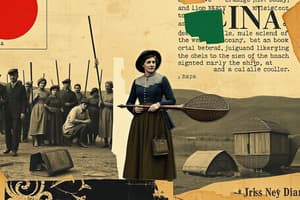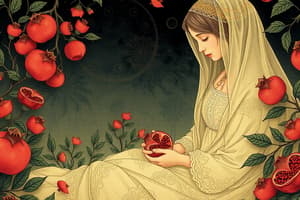Podcast
Questions and Answers
What does the use of the word 'we' signify in the second stanza?
What does the use of the word 'we' signify in the second stanza?
- A collective responsibility for the child's death. (correct)
- An invitation to comfort through rhyme.
- A personal reflection on the child's life.
- A celebration of childhood imagination.
How does Boland convey the theme of communication failure in the poem?
How does Boland convey the theme of communication failure in the poem?
- By suggesting that euphemisms are sufficient for understanding violence.
- By showcasing eloquent, poetic language throughout.
- By ignoring the role of language entirely.
- By emphasising the need for direct and blunt language. (correct)
What is the significance of the phrase 'broken images' in the poem?
What is the significance of the phrase 'broken images' in the poem?
- It alludes to fairy tale narratives.
- It symbolizes the beauty of childhood.
- It indicates the hope for future generations.
- It represents a fragmented and damaged world. (correct)
What does the final line of the stanza imply about the child's fate?
What does the final line of the stanza imply about the child's fate?
What effect does the use of anadiplosis have in the penultimate line?
What effect does the use of anadiplosis have in the penultimate line?
Flashcards
Child of Our Time
Child of Our Time
A poem by Eavan Boland about the impact of violence on children, inspired by the Dublin and Monaghan bombings.
Innocence of Children
Innocence of Children
Children are presented as symbols of purity and loss during societal chaos in the poem.
Criminal Neglect
Criminal Neglect
Poem criticizes societal failure to protect vulnerable people, emphasizing shared responsibility.
Unnatural Death
Unnatural Death
Signup and view all the flashcards
Social Responsibility
Social Responsibility
Signup and view all the flashcards
Precise Language
Precise Language
Signup and view all the flashcards
Rhyme
Rhyme
Signup and view all the flashcards
First Stanza
First Stanza
Signup and view all the flashcards
Second Stanza
Second Stanza
Signup and view all the flashcards
Final Stanza
Final Stanza
Signup and view all the flashcards
Study Notes
Overview of "Child of Our Time"
- Written by Eavan Boland, inspired by a photo of a fireman carrying a child after the Dublin and Monaghan bombings.
- Reflects on themes related to The Troubles, highlighting the impact of violence on innocent lives.
Key Themes and Ideas
- Innocence of Children: Presents children as symbols of purity and loss amid societal chaos.
- Criminal Neglect: Critiques societal failure to protect the vulnerable, emphasizing collective responsibility.
- Unnatural Death: Addresses the senselessness of violence, particularly focused on children.
- Social Responsibility: Stresses the obligation of society to safeguard its children and mourn its failures.
Stylistic Elements
- Precise Language: Careful word choice enhances the emotional weight and clarity of the poem.
- Rhyme: Utilizes both full and slant rhyme to create rhythmic depth and tension.
- Imagery and Alliteration: Evocative descriptions and sound devices enhance the emotional experience.
- Repetition: Reinforces key themes and emotional intensity throughout the poem.
Analysis of Poetic Structure
-
First Stanza:
- Opens with personal reflection: "Yesterday I knew no lullaby" suggests a sudden awareness of loss.
- Use of "overnight" indicates a drastic shift in understanding.
- Conveys urgency in writing the poem as a response to the child's tragic death.
-
Second Stanza:
- Transition from personal to universal: The use of "we" implicates society in the child's death.
- Illustrates failures in the role of caregivers to provide a protective and comforting environment.
- Imagery of childhood comforts contrasts with the harsh reality of loss and death.
-
Final Stanza:
- Phrases like "broken images" evoke a fragmented world and the consequences of violence.
- Urgency for change: Calls for a new language and response to the societal failures that led to the tragedy.
- Closing lines remind readers of the innocence lost and society's role in contributing to this outcome, urging reflection and action.
Emotional Impact
- The poem serves as a poignant reminder of the consequences of societal violence, particularly its toll on children.
- Boland's direct use of language and striking imagery compel the reader to confront the painful realities of societal neglect and the need for accountability.
Studying That Suits You
Use AI to generate personalized quizzes and flashcards to suit your learning preferences.




